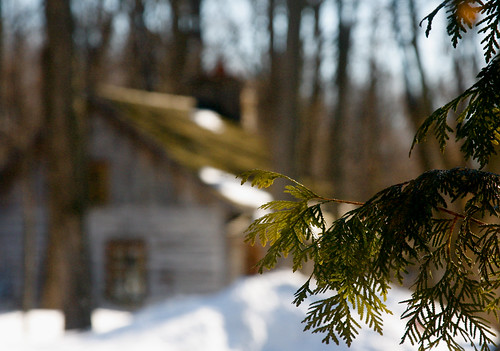We worked from the old posterboard my mom left, all the family research she had made into a tree from her trips to St. Joseph Church in Prairie du Rocher, Randolph Co. Historical Society, the church at Ste. Genevieve, the trip we made to Kaskaskia with Grandma-- where she of
met a cousin, Missouri Historical Society, letters to Quebec. So far I can't figure out how to post a family tree that anyone can copy and print from here, but I thought I would just post Taylor's paper here because it seems like a good start. I've left out the parts that weren't about this line of family and added some pictures and links that weren't in her paper.
 |
| Louis IX |
The D'Amours were Conseilleurs (advisors) to the kings of France since 1246, when a D'Amours saved the life of Louis IX, known as St. Louis, during the “Nobles' Revolt”. From that time, his descendents were kept as advisors and favored members of the French Court, given titles and seignieuries (similar to fiefdoms in Britain) by the Kings of France until the French Revolution. It was said that the D'Amours were reliable, trustworthy and did not get involved in Court intrigue.

Mathurin D'Amours (1399-1459), Seigneur du Serrin, married Marguerite de Bridee and received the first D'Amours Family Crest in 1450. "On Silver backdrop, a sable porcupine, "lambel" on top, three nails below". Pierre D'amours, born in 1425 in Durtal, Anjou, was father to François D'amours du Serrin.
 |
| Louis holding Court in his bedchamber |
François was rewarded by Louis XII by having a seat on the "Conseil Royal" (Royal Council): François was appointed on July 5th 1489, both as Councillor and as Maitre d' of King Louis XII's household. François D'Amours (1455-1510) married Gillette
Hennequin in Paris on August 10, 1496.
Their son, Gabriel D'Amours, seigneur du Serrin, born in Durtal, Anjou, was married in Paris, on June 14, 1531, to Madeleine de Bidaut, daughter of Charles de Bidaut (secretary to the King) and Catherine Auvrillot de Champlastroux. Of their 8 children, we are descendents of Gabriel and Madeleine's son, Pierre D'Amours Louvières, a knight, sieur du Serrin, Conseiller d'Etat et prive du Roi(State and private counselor of the King), surintendant of Justice in Troyes, France. He is the first D'Amour to hold the title Louvieres. In Paris on January
13th, 1561, Pierre married Lady Jeanne le Prevost, daughter of Jean Le Prevost, counsellor to the King, and Anne le Clerc. It is through the ancestry of Anne Le Clerc that we are descended from Eleanor d'Aquitaine, King Phillippe I, William the Conqueror and Charlemagne.

On the left is the first D'Amours Manor built by Pierre in Durtal, in the Anjou region of France. He and his wife had several children.
Below are pictures of the manor as it looks today. It is currently under renovation.
 |
| The ancestral D'Amours manor in Durtal as it looked in 2002 when family members traveled to France. |
 |
| The Rose Garden |
 |
| The Pigeonniere |


Pierre and Anne's second son, Louis D'Amours, married Anne de Gravelle in St-Gervais, on September 11, 1614. Louis D'Amours also had a son and three daughters by Elisabeth Tessier (daughter of Jean-Valere Tessier and Livia Branbille). He had these children legitimized.
 |
New D'Amour shield as approved by the Sovereign Council of Quebec
The porcupine is replaced by a boar. |
Their son Mathieu was born in 1618 in the Parish of St-Paul, in Paris. Mathieu D'Amours des Caufors, et de la Morandiere, first Seigneur of Matane, Quebec, “Major des Troupes”, was 33 years old in 1651 when he arrived in Quebec with the Governor Lauzon. His sister Elisabeth was on the same ship, married to Louis-Théandre Chartier de Lotbinière, whose Mother was the First Chambermaid of the Queen.
He fell in love with the oldest daughter of Nicolas Marsolet de Saint Aignan, one of three men who traveled with Champlain to Quebec about 1613 and who was the first interpreter of Montaignais and Algonqin languages.
Nicolas lived for many years among these tribes, learning their language and living in their ways. He would impart his knowledge of tribal languages to no one, saying that he had given his promise to the Indians. According to writings by Champlain about him, his attitudes towards the natives infuriated him. Nicolas returned to Rouen, France, until Champlain died. At the age of 35 he married Marie LeBarbier, 17. When he received a seigneury in New France, they returned and settled at Bellechasse to raise 11 children. Their oldest daughter, Marie, married Mathieu D'Amours when she was 15. Having lived among the Algonquins from an early age, Marie became an official interpreter for the government.

The King had granted Mathieu a significant estate with frontage on the St. Lawrence River. Marie's dowry was that for three years, her father agreed to provide them with a house, some land, all necessities including food, two hired hands, a cow and two oxen. It would take these years to clear this property for agriculture on a self-sustaining basis. They stayed in her father's house while they had their first three children, Nicolas, Louis, Mathieu, but decided they preferred city life so in 1657 moved closer to Quebec City.
There they had 12 more children, and managed to educate them all in Catholic seminaries so that they would all be prepared for society and to secure noble marriages.
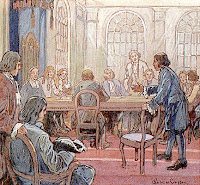 |
| Sovereign Council of Quebec |
In 1663, Mathieu was named one of the seven founding members of the Sovereign Council, ranking only behind the governor and the bishop. He remained a member until his death in 1695, succeeded by his son Mathieu. The Council adjudicated all administrative, civil, legal and criminal matters in New France.
 In 1672, the huge seigneury of Matane was awarded to Mathieu. At that time, he also received the right to fish commercially on both the Matane and St. Lawrence Rivers and trap furs on the large property. Because it was so far from Quebec, and because of his military obligations and preference for city life, he never developed Matan
In 1672, the huge seigneury of Matane was awarded to Mathieu. At that time, he also received the right to fish commercially on both the Matane and St. Lawrence Rivers and trap furs on the large property. Because it was so far from Quebec, and because of his military obligations and preference for city life, he never developed Matane agriculturally. He was interested in fishing and fur trade. At Matane today the D'Amours family crest can still be seen on the doors of some public buildings.
Mathieu also received three concessions of land for his sons on the Riviere St. Jean. His sons' farms were considered model operations, but things turned out badly because the properties were located on the route used by the British troops of Maine when Quebec was held under siege. Between the English and flooding, the properties were lost.
Our ancestor Charles D'Amours de Louvieres, Sieur du Lac Matapedia, was the 6th child in the family, born March 05, 1662, Guadarville, Quebec. In 1697 he married Anne-Marie Louise Thibodeaux, one of 18 children of Pierre Thibodeaux and Jeanne Theriault/Theriot from Port Royal in Acadia. Like a good gumbo, this is the branch of the family that gives us our spice.
 |
| Memorial to Pierre Thibodeaux |
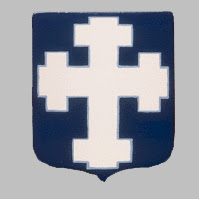 |
Family crest
Theriot/Theriault/Terriot/Terriau |
A memorial plaque for Pierre Thibodeaux is in Acadia. Jeanne's family had been in Acadia for 3 generations.
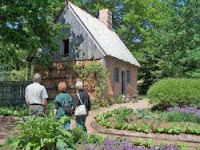 |
| Acadian house at Port Royal |
For both Charles and Anne-Marie, this was their second marriage. Together they had 10 more children. One of them was Pierre des Chaufour D'Amour de Louvieres. Charles was drowned in a fishing expedition in 1716. Pierre was in the military as all his family before him, and also traveled regularly the St. Lawrence River, down the Mississippi and back, trading furs and merchandise along the way. The territory of New France covered the middle of the continent and the King of France wanted it settled to protect the interests of France. He had the military build forts at regular intervals according to the recommendations of his explorers and had cartographers making surveys of the land, rivers, natural resources and existing villages. He encouraged marriage with native women.
 |
| Old Kaskaskia Village as viewed from the bluff |
Pierre may have continued his travels but is soon listed as having traded for a 2 story stone house at Kaskaskia, in the Illinois Country.
 |
| Fort de Chartres as rebuilt in 1750 |
His son, Antoine Valentin D'Amours de Louviere, had properties both at Kaskaskia and in the little village of Prairie du Rocher, which was about 4 miles from Fort de Chartres at that time. They settled into the area, becoming syndics of the village (like a justice of the peace). Antoine became Captain of the Militia like his father before him.
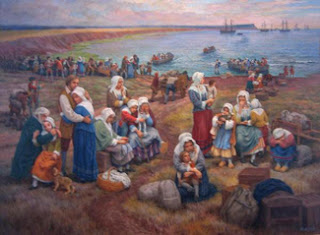 |
Le Grande Derangement
The Deportation of the Acadians by the English
They were far from the deportation happening back in Acadie. Many of our Acadian cousins had their homes burned, livestock killed, and were put on boats to try to find a place they could land. Some drowned in the decrepit boats. Some were turned away at port after port in New England. Many ended up in Louisiana. Many families were separated and never saw or heard from each other again. |
After the Seven Years' War, there was the Treaty of Paris in 1763. It gave all the territory east of the Mississippi River to the British. Kaskaskia was a thriving river settlement, it suffered far more under the British than the tiny village of Prairie du Rocher. Although their services as officers at the Fort would no longer be needed, it was years before the British actually came to take possession of their new territory. The French people felt abandoned by their King, who they had worked for and been loyal to. Many, many people fled to the west side of the river, believing it still to be French territory. But the King of France had given it to Spain in a secret treaty. Still, better to live under Spanish rule than the hated British. Many of our ancestors from Cahokia, Kaskaskia and the other villages close to Fort de Chartres, St. Phillipe and the Village of Chartres, went to Ste. Genevieve.

Pierre LaClede Liguest spent the winter at Fort de Chartres and talked to people about following him to the new settlement he was beginning at the confluence of the Mississippi and the Missouri Rivers-- on the west side! Some of my ancestors followed him there. The people literally took down their houses, packed the materials on boats, and crossed the river to their new properties. But the D'Amour de Louviere families stayed. It probably had to do with being military officers, both a responsibility to maintain their post until relieved, but also possibly to protect those people who were not able to leave. When the British did finally arrive, they decided the fort was too much trouble to maintain and allowed it to fall to ruin. Once it was abandoned, many of the villagers used the cut stones in their own homes and properties. There was a French saying, “Better to take it before somebody else steals it!”
 |
| Foundation of Antoine and Marie Louise's home in the old village |
Antoine Valentin married Marie Louise Gaudere, whose family had recently come to the village from the fort at Vincennes. Her mother's family was Richard, they were Acadienne. They had many children, who intermarried with the families in the village of Prairie du Rocher down through the generations. His son who was our ancestor was Antoine D'Amour de Louviere, born in Prairie du Rocher. Antoine was born the same year his grandfather Pierre died, 1768. He was also syndic for the village under the Americans. He married Marie Louise Langlois. The foundation of their home in the original village had been covered by the Mississippi floods but was recently excavated and documented by archeologists. They found a lot of artifacts that belonged to my family, including a buried whiskey pot in the cellar. The site is beside the cemetery road.
Their son who was my ancestor was named Jean Noel D'Amour de Louviere, born in 1802. Jean Noel outlived three wives, all were named Marie Louise. His farm property included the “old fort” as everybody called it then. By the time he was an old man, his name had been Americanized in a book of pioneers as John N. Louvier. He died in 1887.
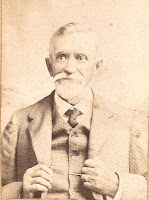 |
Gabriel Louvier
"Grandpa Gab" |
The mother of Gabriel Louvier, my great great great grandfather, was Marie Louise Blais. Gabriel was born in Prairie du Rocher in 1839 and married Marie Boyer. It is said that most of the family's property was gambled away on horse races that he would arrange in the road that ran in front of the church. Ah, well, his family loved Grandpa Gab anyway. He often stayed in St. Louis with his brother Raymo (probably Raymond) and Raymo's wife, who made their living at the racetrack until Raymo got a job as electrician at the downtown Famous Barr. Grandpa Gab died in St. Louis.
His son was also named Gabriel Louvier. He was known to his children and all future generations as Pep. He was born in 1864, the oldest, and helped raise his brothers and sisters after his mother died. Some were still at home when he married so the little ones stayed with them often.
 |
Philomen Charleville
"Mem" |
He married Philomen Charleville, shortened by the Americans from Chauvin dit (called by) Charleville. In her ancestry were Roys and Rivard dit LaVignes who had first settled Fort Louis, later to become Mobile, first settlers of Bayou St. Jean before New Orleans was planned, François Valle, who had absolutely no formal education but started a lead mining operation and went on to be the most powerful man in Ste. Genevieve, Becquettes who were among the first settlers of St. Louis and many, many metis, mixed French and Indian blood. She was known to her children and grandchildren as Mem. They had a daughter, Alice, and then four boys.
 |
| Mem and Pep on their farm in Prairie du Rocher, Ned in upper left |
The family decided to celebrate the American holiday of Thanksgiving when their boys came home from school talking about it. The boys went out hunting for a turkey and their youngest brother was accidentally shot through the neck as they were cleaning the gun. He died three days later. So my great grandfather, Lawrence, born in 1896, was now the youngest. Philomen named all her boys François after her father and brother, then called them by their middle names-- Roger, Edgar, Lawrence. None of them knew they had been baptised François until my grandmother was looking at the church records for genealogy. None of them knew their family name was D'Amour, and that Louviere had been the title of their seignieury.
 |
Lawrence Louvier
Navy WWI |
They were the first generation to speak English. He told his parents to “talk American” and when WWI started, he enlisted in the Navy. He was the first generation since Antoine to be back in the military where the D'Amours had always been. Apparently farm life didn't suit him either because he sold his house, land and the ripe wheat crop standing in the field to take his young wife and their baby twins to St. Louis, where he lived the rest of his life. But he never forgot he was French, or missed a weekend playing the fiddle to all the old French songs for the Rocher dances on Saturday nights. And he taught his grandchildren the French words to a tune that goes back to a medieval tradition, La Guiannee, that has been held in Prairie du Rocher since 1722. I would hate to miss a New Year without hearing La Guiannee in Prairie du Rocher. It feels like family.
François Lawrence Louvier
Gabriel Louvier “Pep”
Philomen Louvier nee Charleville “Mem”
Alice Louvier
on the farm at Prairie du Rocher Illinois
 This soup has to be made with yellow split peas or it's just pea soup. When it's snowing and I want to connect with the ancestors I make a pot of this and leave it simmering on the back of the stove so the house smells good. I like it with some kind of brown rolls or bread and lots of butter. Yellow peas are hard to find around St. Louis, I have found them in Whole Foods (Whole Paycheck as my sister calls it!) but they are not as outrageous as some of their other foods.
This soup has to be made with yellow split peas or it's just pea soup. When it's snowing and I want to connect with the ancestors I make a pot of this and leave it simmering on the back of the stove so the house smells good. I like it with some kind of brown rolls or bread and lots of butter. Yellow peas are hard to find around St. Louis, I have found them in Whole Foods (Whole Paycheck as my sister calls it!) but they are not as outrageous as some of their other foods.
